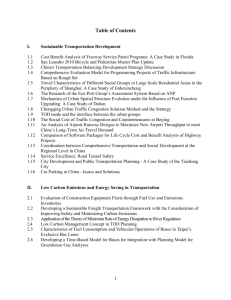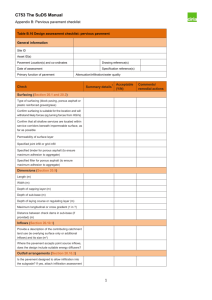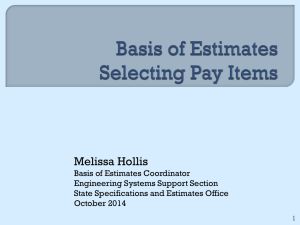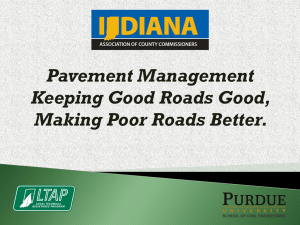Recycling Project Selection Guideline
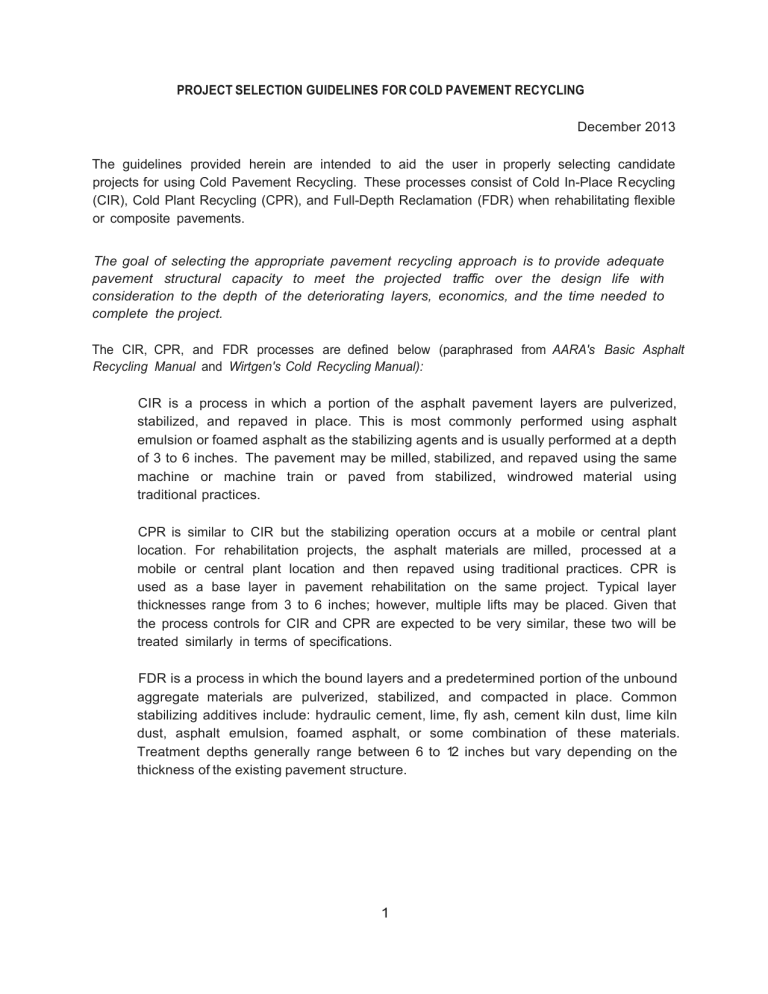
PROJECT SELECTION GUIDELINES FOR COLD PAVEMENT RECYCLING
December 2013
The guidelines provided herein are intended to aid the user in properly selecting candidate projects for using Cold Pavement Recycling. These processes consist of Cold In-Place R ecycling
(CIR), Cold Plant Recycling (CPR), and Full-Depth Reclamation (FDR) when rehabilitating flexible or composite pavements.
The goal of selecting the appropriate pavement recycling approach is to provide adequate pavement structural capacity to meet the projected traffic over the design life with consideration to the depth of the deteriorating layers, economics, and the time needed to complete the project.
The CIR, CPR, and FDR processes are defined below (paraphrased from AARA's Basic Asphalt
Recycling Manual and Wirtgen's Cold Recycling Manual):
CIR is a process in which a portion of the asphalt pavement layers are pulverized, stabilized, and repaved in place. This is most commonly performed using asphalt emulsion or foamed asphalt as the stabilizing agents and is usually performed at a depth of 3 to 6 inches. The pavement may be milled , stabilized, and repaved using the same machine or machine train or paved from stabilized, windrowed material using traditional practices.
CPR is similar to CIR but the stabilizing operation occurs at a mobile or central plant location . For rehabilitation projects, the asphalt materials are milled, processed at a mobile or central plant location and then repaved using traditional practices. CPR is used as a base layer in pavement rehabilitation on the same project. Typical layer thicknesses range from 3 to 6 inches; however, multiple lifts may be placed . Given that the process controls for CIR and CPR are expected to be very similar, these two will be treated similarly in terms of specifications.
FDR is a process in which the bound layers and a predetermined portion of the unbound aggregate materials are pulverized, stabilized, and compacted in place. Common stabilizing additives include: hydraulic cement , lime, fly ash, cement kiln dust, lime kiln dust, asphalt emulsion, foamed asphalt, or some combination of these materials.
Treatment depths generally range between 6 to 12 inches but vary depending on the thickness of the existing pavement structure.
1
Considerations for R e h a b i l i t a t i o n /Reconstruction Projects
Initial Project Selection Criteria
Appropriate pavement recycling candidate projects should be identified by first obtaining the following information:
1. Distress Rating Data - Projects identified as RM
1 or RC
2 sites are typically suitable candidates.
2. Project Length - The total project length should be greater than approximately 5 lane miles for CIR or greater than approximately 3 lane miles for FDR. The total project length can be any size for CPR on rehabilitation projects.
3. Maintenance History - A substantial rehabilitation effort may be needed if existing or projected patching exceeds approximately 15% of the pavement surface area or if applied overlays do not achieve their expected service life.
4. Pavement Management System (PMS) History - The PMS can be used to obtain the total bound and unbound layer thickness, the layers material composition, and the Critical
Condition Index (CCI) values with respect to time.
Project-Level Pavement Forensic Investigation
It is essential to conduct a project level field forensic investigation to identify the failure mechanism on the project. The Materials Division Manual of Instructions, Section 600 discusses the required elements of a project-level pavement forensic investigation. Additionally, the use of ground-penetrating radar (GPR) is strongly recommended to determine layer thicknesses and identify changes in pavement structure.
If FDR is considered, soil borings shall be conducted to classify the aggregate base and subgrade materials (USCS Soil Classification). The results of the classification tests shall be used to determine the choice of stabilizing agent(s). Generally, cohesive materials should be stabilized using lime. Non-cohesive materials may be stabilized with cementitious or bituminous stabilizing agents (with cementitious stabilizing agents being preferred for silty materials).
Project-Level Recycling Considerations
FDR is intended to correct pavement deterioration due to failures in the subgrade or unbound base /subbase layers for flexible pavement structures. A layer coefficient value for FDR of 0 .
20 shall be used for design purposes .
CIR is intended to correct pavement deterioration within the bound layers of a flexible pavement or the asphalt layers of a composite pavement. CIR is typically performed at 3 to 6 inch depth. A layer coefficient value for CIR of 0.30 shall be used for design purposes. When
1
RM is defined as Restorative Maintenance by VDOT's Maintenance Division "Supporting Document for the
Development and Enhancement of the Pavement Maintenance Decision Matrices" (2011) .
2
RC is defined as Reconstruction by VDOT's Maintenance Division "Supporting Document for the Development and
Enhancement of the Pavement Maintenance Decision Matrices" (2011).
2
the pavement deterioration is located within approximately 3 inches of the surface, CIR may not be as cost effective as a typical mill and fill. When pavement deterioration is located within approximately the bottom two inches of thick bound layers, CIR is usually not a good candidate as the existing pavement structure may not be able to support the weight of the construction equipment. In these cases, FDR should be considered to stabilize this area in place or CPR could be used to reconstruct the bound layer(s) after milling the overlying material.
CPR is intended to repair pavement deterioration within the bound or unbound layers of a flexible or composite pavement.
CPR is typically applied at a 3 to 6 inch lifts ; multiple lifts can be placed for depths exceeding 6 inches. A layer coefficient value of 0.30 for CPR shall be used for design purposes.
Surface Layer Options
Typically, pavement recycling projects are surfaced by one or more layers of asphalt concrete.
The thickness is usually determined by structural capacity requi r ements (refer to Manual of
Instructions, Section 600). Alternatively, recycled materials can be surface treated on low volume routes.
However, for all Interstate routes and Primary routes, the recycled materials shall be covered with a multi-layer asphalt concrete overlay having a minimum combined thickness of 3.5 inches. Similarly, routes other than Interstates or Primaries where the design traffic loading exceeds 3 million ESALs, the recycled materials shall be covered with a multi-layer asphalt concrete overlay having a minimum combined thickness of 3.5 inches. Asphalt concrete leveling courses are not to be considered as part of the multi-layer asphalt concrete overlay.
When a single-lift asphalt concrete surface course is placed on top of the recycled material, profile milling m a y be performed prior to placement of the asphalt concrete overlay to improve ride quality.
Final Project Selection
After completion of the project level forensic investigation and identifying the failure mechanism, the final treatment selection shall be made by assessing all the competing options with estimated cost, time, and any other project specific constraints. Project specific constraints to consider include pavement grade. CIR and FDR methods, as is typical with remixing of in place materials, have potential to increase volume up to 10% over the specified depth during production . This additional depth of recycled layer should be accounted for in the final elevation. If the final depth of recycled layer and asphalt overlay is not acceptable, consideration of pre-milling the existing pavement or profile milling after the recycling operation has been completed should be given . Depending on the project specific conditions, pavement recycling may or may not be selected . If applied appropriately, pavement recycling is expected to reduce project cost and/or completion time.
The District Materials Engineer or designated Responsible Charge Engineer shall complete a pavement design report with their professional engineer's seal affixed to the report. The
3
completed pavement design report shall be submitted to the State Materials Engineer for review and concurrence. The exception for submitting a report to the State Materials
Engineer for review and concurrence will be for Secondary roads. For the secondary road projects, the District Materials Engineer shall, however, provide notification to the State
Materials Engineer about the project.
Exceptions
Any exceptions to these Guidelines shall be submitted to the State Materials Engineer for review and approval.
4

